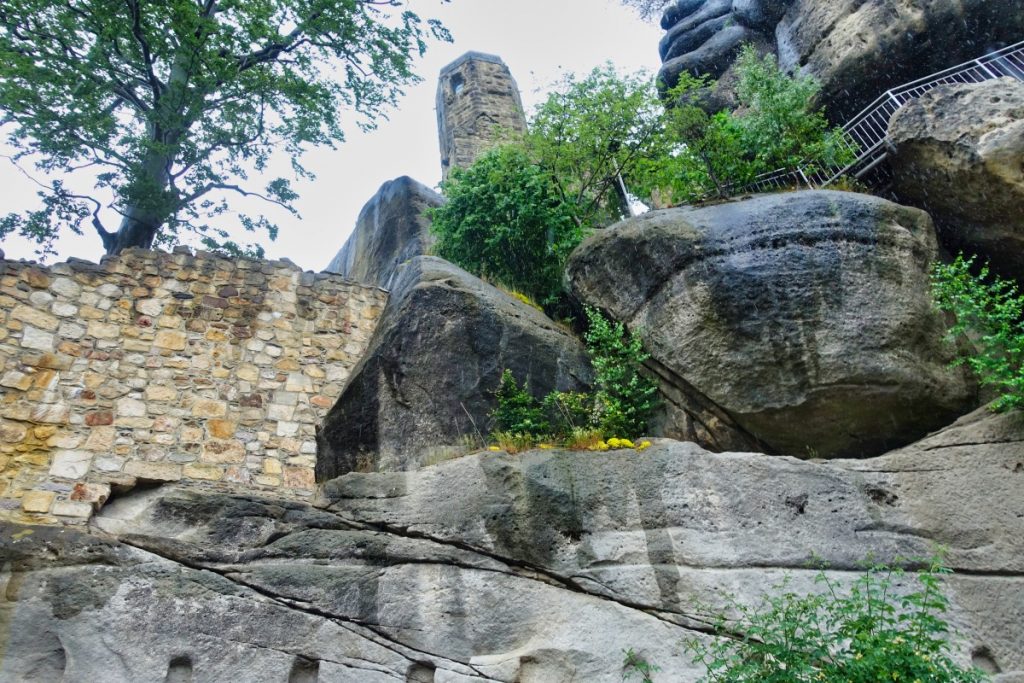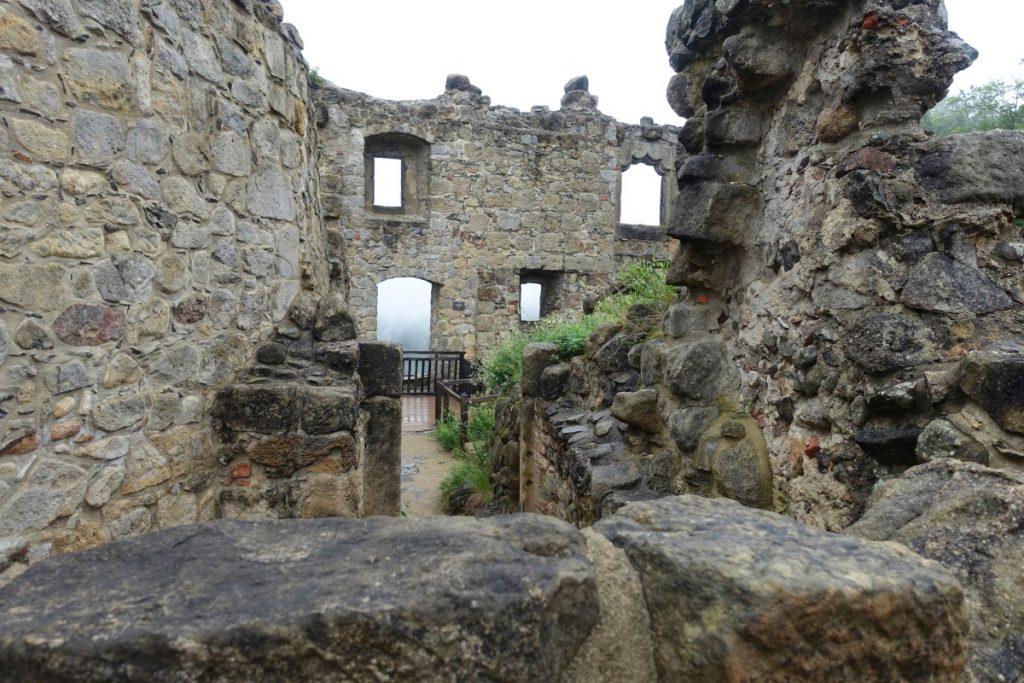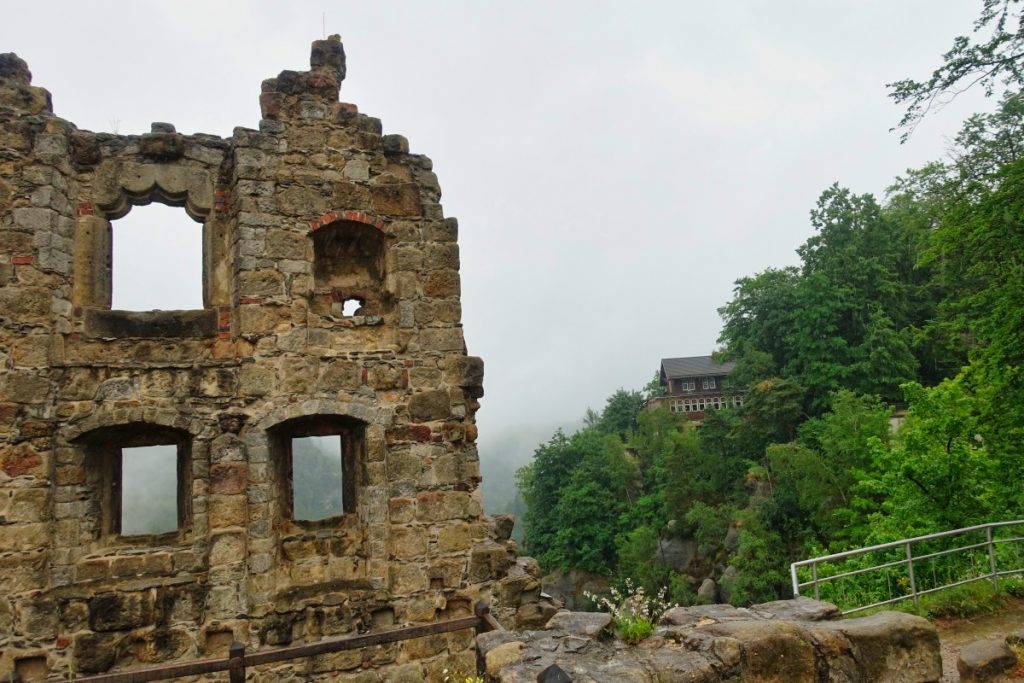In the Zittau Mountains in Saxony lies the small town of Oybin. Above the village rises the Oybin, a 514 meter high mountain and on it are the ruins of Oybin Castle. A place that is interesting not only for fans of castles, but has written a piece of history.
It rains without a break, the clouds hang low and when I look from my hotel window up the Oybin, I see nothing. Up there should be the ruins of a castle and monastery complex and that’s exactly what I’m about to visit.

From the village you can reach the castle complex via a footpath that leads past the mountain church of Oybin. I was here the day before and admired the beautiful paintings in the church.

The hilltop castle extends over the entire summit area and, in addition to the actual castle complex, there are also the ruins of the monastery and imperial house and a hilltop cemetery that is still in use today.
Leap into the past
The earliest traces of construction found on Oybin date back to the 13th century. There was a castle-like complex from which robber barons planned their raids.
In 1291, there is evidence that this facility was destroyed by the city of Zittau, but it was rebuilt a short time later.

In the period 1311-1316, the complex was expanded into a fortified castle to protect the nearby trade routes.
From 1346 the complex belonged to the Bohemian crown. Charles IV had the imperial house built, which he intended to use as a retirement residence. In 1366, he also ordered the construction of the Gothic church on Oybin and donated a monastery on the mountain to the Order of the Cölestines. Six to twelve monks lived here at a time. Today we know that the monks were very technically proficient. For example, research has found that they had underfloor heating in their monastery and were also responsible for the construction of water pipes to Zittau.

In the time of the Hussite wars, the Hussites unsuccessfully besieged the mountain and their attacks were also unsuccessful. Oybin was considered impregnable. So it happened that a part of the Prague cathedral treasure from St. Vitus Cathedral was brought there to safety.
The destruction
During the time of the Reformation, the monastery on Oybin was dissolved. Slowly the first buildings began to decay.
Then in 1577 there was a major disaster. Lightning struck the church and it burned down almost completely. No reconstruction took place and with time the castle area was completely uninhabited. The inhabitants from the valley used the ruins as a “material store” and helped themselves to the stones for the construction of their houses.

In 1681 came the next catastrophe. A rockfall broke loose and destroyed other parts of the castle complex. A fire broke out that is said to have burned for almost two weeks. Stored powder exploded and some areas collapsed.
The castle ruin in romanticism
Almost forgotten, the ruin lay on the mountain. It was not until the Saxon painter Johann Alexander Thiele that it was awakened from its slumber. He painted the overgrown ruin and thus gave it an unintentional popularity. Caspar David Friedrich and other painters were also attracted by the Romanesque backdrop and numerous paintings were created, which can be admired in museums today.

In 1829, the ruins began to be cleared of rubble and the imperial house was renovated to save it from decay. The newly established express carriage service and the narrow-gauge railroad brought spa guests and hikers to Oybin. Even a small museum was established.
Nevertheless, the decay continued to gnaw at the ruin and until today one tries everything with renovation measures to preserve the building.
Visit to the ruins of Oybin Castle
After a few minutes walk, which is quite steep uphill, you reach the castle entrance. If you don’t dare to walk up this way, you can also take a small tourist train up the road.
The interior of the monastery and castle ruins can be visited for a fee, there is also the possibility to walk along a circular path across the plateau.
After passing the current entrance via a wooden bridge at the first tower, a path leads uphill to a small square. Here is a museum in the former residential tower that deals with the history of the castle and monastery complex Oybin.

The tour between the remains of the walls and in the exposed areas is impressive. The weather had not improved during my visit and low-hanging clouds moved around the rocks and denied a view into the valley. Now, if there had been clouds of fog moving through the ruins, the place would have made the ideal movie set.
I was particularly impressed by the remains of the church. A high room, in this case without a ceiling, with impressive window openings. I would have loved to hear a choir singing here, because the acoustics are still impressive.

In good weather and without rain, I would have liked to roam longer and explore. So I left the ruins in Oybin and walked through the narrow Ritterschlucht back into the valley. From there, I then started an exciting three-day pilgrimage hike on the Via Sacra.
Opening hours:
November till March 10-16h
April till October 9am-6pm
Admission fees:
Adults:
November-March: 5,-€
April-October: 8,-€
Guided tours on various topics are also available for a fee.
Disclosure: The visit to Oybin was part of a press trip to Upper Lusatia. The article was written independently of the trip.








Leave a Reply